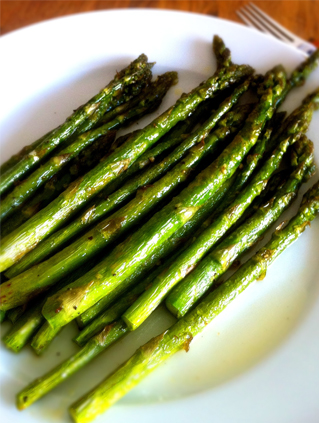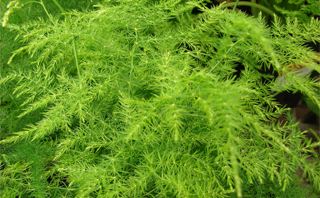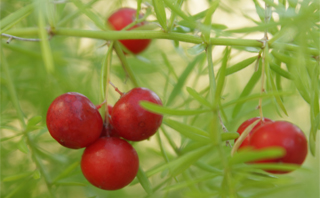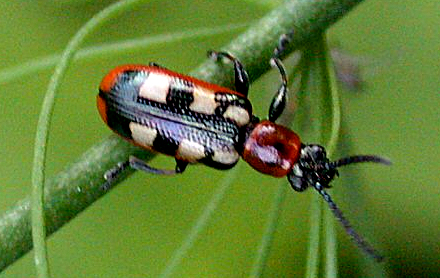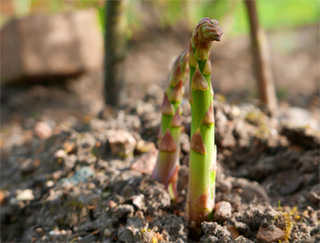
Growing the Best Asparagus in Oregon, Washington and British Columbia.
Asparagus is a perennial vegetable: choose the right location, prepare the soil well, and you’ll enjoy delicious spears for twenty years or more! Asparagus is a member of the lily family which includes onions, leeks and garlic and is one of the first vegetables harvested in the spring.
Asparagus and Your Health
Asparagus is high in anti-inflammatory nutrients and provides a wide variety of antioxidant nutrients, including vitamin C, beta-carotene, vitamin E, and the minerals manganese, selenium and zinc.
Asparagus is especially rich in glutathione, a detoxifying compound that can help destroy carcinogens and protect skin from sun damage. Glutathione also helps protect against certain cancers, including bone, breast, lung and colon cancers. As if that isn’t enough glutathione is thought to slow the aging process, according to an article in The Lancet journal. Asparagus also contains the amino acid asparagine, as well as chromium, a trace mineral that helps insulin transport glucose more efficiently.
Asparagus is exceptionally high in vitamin K, which helps blood clot. In addition, it’s high level of B vitamins helps regulate the amino acid homocysteine. High levels of homocysteine are a serious risk factor in heart disease. Asparagus also provides folate that works with B12 to prevent cognitive decline and lowers the risk of birth defects. Finally, asparagus has more than 1 gram of soluble fiber per cup which helps prevent heart disease.
Seasonal To-do List
Spring
- Plant roots or seeds.
- Fertilize existing beds.
- Apply slug bait.
- Harvest spears no smaller than a pencil.
Summer
- Spray asparagus beetles with Pyrethrum or Neem.
- Bee Alert: Honey bees and especially bumblebees love asparagus pollen – never use these pesticides when plants are flowering. Read more under “Pests” below.
Fall
- Cut back yellow fronds to the ground.
- Add lime, seaweed and mulch or manure.
Winter
- Cover beds with plastic or tarps.
Location
In the fall, prepare your bed in a sunny, well-drained location. Asparagus hates wet roots and is subject to soil-borne diseases if drainage is not excellent. Fall or very early spring preparation ensures that compost will be integrated into the existed soil. The bed can be raised or semi-raised and should be deeply dug and amended to provide rich, light soil.
Our friend Bryn started two beds when she moved to a new home: the one with the best drainage, on the north end of the garden on the edge of a gently downward sloping orchard, thrived, while the one on the south end with poor drainage has limped along. Installing perforated drain pipe under a bed or a nearby path is also an option if the water can drain to a lower area. The practice of covering raised beds with waterproof tarps during the winter is even more valuable in the case of asparagus.
Planting
Asparagus is usually grown from one-or-year-old roots – this allows a small harvest the second year. It can also be grown from seed but harvest isn’t likely until the third year.
From Seed
If you don’t mind waiting an extra year or two, growing from seed is more economical and often allows a greater choice of varieties. Plant seeds when soil is warm 6-8 inches apart in a row with three feet between rows. Remember that asparagus can grow over five feet tall (they look like big, airy ferns) and will shade nearby beds. You can thin to the healthiest, most robust plants later in summer or wait until the following spring. Permanent plants should be spaced about 2 ½ feet apart. Crowded plants will result in fewer, smaller stalks as they compete for available nutrients.
From Crowns
If planting crowns, dig a trench about 15 inches deep by 18 inches wide in fall or early spring. Spread a layer of compost in the bottom and cover that with an inch or so of good soil. Make a small mound every 20 inches within the trench and plant a crown on each, spreading the roots each crown over the mound. Cover with two inches of soil gently tamped down. When shoots appear, add another two inches of soil. Continue this process, adding two inches of soil every couple of weeks until the trench is filled in. Keep the bed weed and grass-free with careful hoeing.
Mulching
Apply 2-3 inches of manure or well-aged compost in the fall. This is also the time to remove all growth that has died and turned brown. Asparagus are heavy feeders and need consistent additions of aged compost and/or complete organic fertilizer to produce well. Seaweed is especially beneficial for asparagus. Like most things from the sea, seaweed is high in micronutrients and asparagus is quite tolerant of salt so even fresh seaweed is a valuable addition.
Water
During the first year, keep the bed well-watered but not soggy. In subsequent years, an inch or two per week should suffice.
Male vs. female plants
When shopping for asparagus crowns, you will see “all male” selections. Why are male plants more desirable? Because seed-making requires huge energy resources, thus leaving female plants with less energy to store and use in stalk production. If growing from seed, you can thin out female plants in the fall when the red seed balls form on the stalks. Also thin out any self-sown plants that do happen to grow from dropped seeds to prevent crowding.
Harvest
Begin harvesting from your bed when stalks grow as big around as your thumb, usually in the second year after planting. Cut the stalks with a sharp knife just below the soil surface or break off just above the thicker low portion of the stalk. Stop harvesting when spears only grow to the size of a pencil. The tall, ferny plants will gather energy to be stored in the plant roots and produce next year’s crop.
Pests and diseases
The most common pest you will encounter in your asparagus patch is the asparagus beetle. The adult insects, and especially the larvae (which look like tiny slugs), will consume foliage on the growing plants. Control them with Neem or Pyrethrum spray. Even these organic sprays are toxic to honey bees until they dry on the plant so use them only at dawn or dusk when bees aren’t active. If you want to spray during the day use insecticidal soap or knock the beetles into a jar of soapy water. Remember that the leaves are needed to gather energy for root storage and shoot production the following spring. Asparagus beetle larvae can strip every tiny leaf of the stalk and seriously impact next years’ crop. Slugs can be a serious pest in the spring but are easily controlled with traps or bait.
